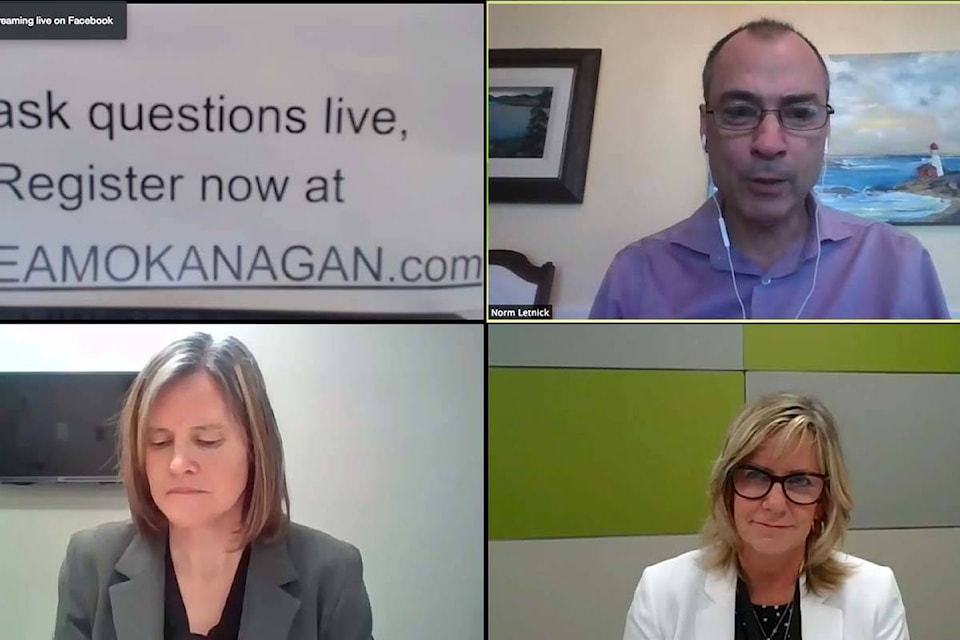Top officials with Interior Health answered public questions over COVID-19 on a wide range of subjects, from health care preparation to best practices for prevention, during a virtual town hall on Friday evening.
Susan Brown, the president and CEO of Interior Health, along with Dr. Sue Pollock, the Chief Medical Officer, spoke on pre-prepared topics, providing general information about the coronavirus and outlining Interior Health’s efforts to prepare and respond to prospective cases around the region.
Norm Letnick, the MLA for Kelowna-Lake Country, moderated the event, posing questions that came in from the public over the livestream.
READ: B.C. COVID-19 contact restrictions working, Dr. Bonnie Henry says
According to the latest update from the provincial government released on Friday, there are 70 positive COVID-19 in the Interior Health region, which are part of the total 792 cases across B.C.
Across Interior Health jurisdiction, there are 10 facilities capable of COVID-19 testing and hundreds of tests have already been completed, according to Pollock.
“In Interior Health, we have a very rigorous testing strategy here, and we are testing everyone who needs a test, but not everyone needs one,” said Dr. Pollock. “So we are focusing right now on four priority groups for testing and those priority groups are health care workers, those residents and staff of long-term care facilities, those individuals who are hospitalized or likely to be hospitalized as well as individuals who are associated with outbreaks or clusters.”
A lab at the Kelowna General Hospital now processes COVID-19 samples — a change from earlier weeks and months, where samples were sent to the BC Centre for Disease Control Public Health Laboratory in the Lower Mainland.
“Our turnaround time would be a few days during that phase of this outbreak, but now that we have testing up and going at KGH, we have a very rapid turnout time, sometimes as quick as 24 hours,” Dr. Pollock said.
So what happens when someone tests positive?
Confirmed cases are immediately reported by the lab to the medical health officer, who follows up with the patient and find out where they’ve been and who they’ve been with during their infectious period, said Dr. Pollock. Investigators will do ‘contact tracing’, and get the names of everyone the patient has been in contact and follow up with them to determine if those contacts are symptomatic.
Anyone experiencing mild symptoms such as a sore throat or a cough should be self isolating for at least 10 days. After that period, if someone is feeling 100 per cent better without symptoms, they’re generally considered non-infectious, according to Dr. Pollock.
Though the number of cases in the B.C. Interior has steadily risen over the weeks, Brown said she is confident that Interior Health will be able to handle the patient capacity if there was a sudden surge.
“We have managed to reduce our in-patient capacity to roughly about 60 per cent today, and our ICU capacity is sitting anywhere between 50-60 per cent,” Brown said. “That allows us a lot of capacity, when you look at the worst case scenario, which was presented to the group earlier on in the technical briefing, we are using that curve to really prepare for the worse, but we are in a very different starting position in the province of B.C. and Interior Health.”
MLA Norm Letnick opens IH virtual town hall by thanking frontline health care workers. Susan Brown, IH president and CEO and Sue Pollock, Chief Medical Officer are online as well. Introductions are underway and then we'll get to questions.
— Trevor Crawley (@tcrawls) March 28, 2020
In contrast, Brown said hospitals in Italy were sitting at 110 per cent capacity when COVID-19 hit, adding that Interior Health hospitals could be stretched to operate at 125 per cent capacity and even bring in a field hospital as an extreme measure in a worst case scenario.
Interior Health has roughly 55 regular ventilator beds across the region, and the ability to go up to 150, said Brown, which would include the use of some operating rooms and different spaces. She adds that province is looking at purchasing more ventilators, and has also been contacted by post-secondary institutions, such as Thompson Rivers University, which is giving Interior Health seven ventilators they use to train students.
Kelowna and Kamloops have the largest hospital and health care infrastructure systems, but Cranbrook, Vernon, Penticton and Trail are served by regional hospitals, while a variety of other hospitals in Interior Health have critical care capacity, according to Brown.
“As we said, it depends on how the virus plays out, how many people are impacted, but all our sites that have ventilators are capable of looking after people,” she said.
Disclosing the locations of which communities have COVID-19 cases has been a frequently raised topic, and has been repeatedly addressed by Dr. Bonnie Henry, the B.C.’s Provincial Health Officer, over the last few weeks.
READ: Why you don’t know which B.C. city has COVID-19 cases - Interior Health explains
Brown said Interior Health continues to follow the direction of Dr. Henry, noting that the strategy “has paid off well” for the province.
“We need people to feel safe, to be able to come forward and be tested,” Brown said. “Right now, B.C. has tested more people in our province than the whole of Ontario, and we have a third of the size of the population, so I think the strategy is paying off, people feel safe to come forward, and bottom line is, it really doesn’t matter where people are, we don’t want people assuming where positive cases are, they could be anywhere. We need to have a high degree of diligence around the different messages we’ve been given by our medical health officers.”
trevor.crawley@cranbrooktownsman.com
Like us on Facebook and follow us on Twitter
